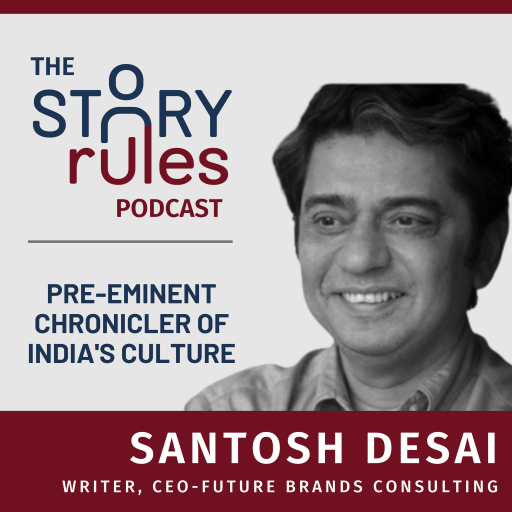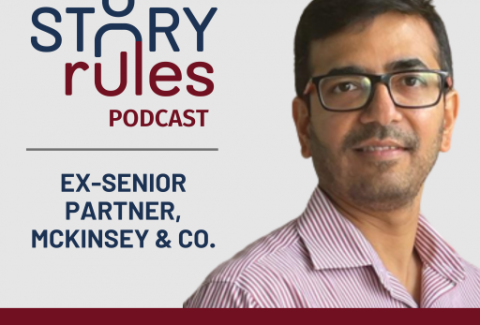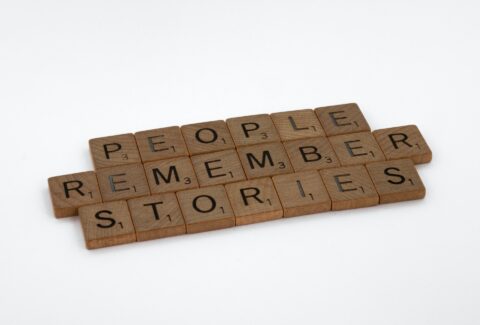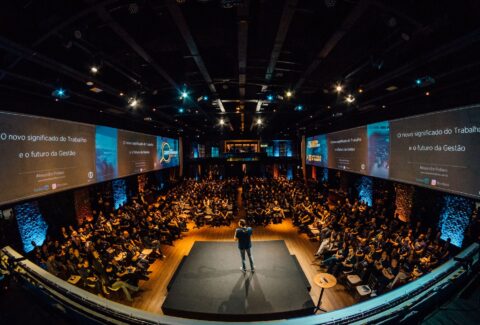E16: Santosh Desai – the pre-eminent chronicler of India’s culture
I’m kicked to release the next episode of my podcast with Santosh Desai.
Santosh wears many hats – he currently heads a brand consulting firm, has headed an ad-agency before, is a published author and is also a long-time columnist for the Times of India.
His weekly column City-City Bang-Bang – which he has been writing for 17 long years – paints a vivid, relatable yet surprising portrait of India’s fascinating culture. Some of these columns have been compiled in a book called ‘Mother Pious Lady: Making Sense of Everyday India‘.
I’ve always been a fan of Santosh’s work. Specifically, his stellar observational skills (which to my surprise, he says are not that great!), his ability to see the unusual in the usual and his almost poetic writing abilities.
In this conversation, we dive into the secrets of how Santosh Desai does his magic. How he views the world with his unique fundamental questions. How he finds patterns and mental models that help him interpret and understand this world… and how he finally brings it all on paper with his lucid and lyrical prose.
It is an eye-opening conversation, especially for left-brain-heavy folks like me who tend to over-rely on data, logic and structure!
As always, I’m sharing some some lightly-edited extracts from the conversation – tagged under ‘the 3Ps’ – the Personal, Philosophical and the Practical (all emphasis mine):
1. Personal:
a. Some fun rituals that Santosh practices to increase bonding 🙂
Ok, this is not so much a ‘personal’ story, but I loved the example of a team ritual that Santosh shared. It’s a ritual that enhances team bonding and builds a shared sense of common stories within the team.
Santosh: Rituals are very important, also. They communicate a lot. Formal communication is the least important, I think, increasingly today. It’s the informal communication (that matters).
Ravi: What’s an example of a good ritual?
Santosh: Let me tell you what will be considered a terrible example. We have this ritual of any new person that joins or anyone who leaves, we have a very wet lunch. There’s a ritual where the new person is welcomed, normally after a few months of them having been around. They have to talk to us about their first impression of the company and then go person by person, and describe how they see that person.
We are a team of 25 people, or actually at any given time there’s 15-20 people; and the same thing happens when they leave. Regardless of (the reason), we always throw a lunch for people who leave. There’s nobody who leaves without (a lunch). And they get to say whatever they want. This is a small ritual, and the reason why the alcohol is important is because it allows people to loosen up and to say stuff that they want – obviously, without getting to the point where they are incoherent.
This is a small, not very significant ritual but I think it’s important because what it communicates is the fact that it’s okay to say what you want. We are interested in your unalloyed, unfiltered opinion, and there’s a conviviality that you create. And what happens is that over a period of time, everybody else has bene through this so there are shared stories of “Oh, so-and-so did this.”
It just becomes a place for storytelling, where there is organizational lore, it just becomes a sight which is looked forward to, celebrated, and yet actually has a meaning. It socializes people into the organization at a certain level, and when somebody is leaving it gives them memories. That’s why we have a whole lot of people who may come back and join us, or who are always present.
The above example brought back some great memories of “wet lunches” (mostly dinners though) with the fabulous crews I worked with – at Feedback Infra and then at B-ABLE!
2. The Philosophical:
a. Observing something is more than seeing it… it means feeling for its essence
Good writing is visual. It paints a vivid picture of the world the writer wants to take you to.
For instance, consider this extract from Santosh’s book (from an essay on the railways titled, ‘The Great Indian Journey’):
The double locking of the metal coffins we called luggage, the strings that held the beddings together, the compacted currency notes in the watchpocket of our trousers, the smug hiding of money in unlikely places in our bags, the plump diving into the blouse for the clasped money bag, the chain lock available on platforms, the stories of educated, well-dressed, ‘people like us’ who chat up the naive, only to make off with the luggage after drugging the food.
For anyone who’s traveled in trains (especially in the 1980s and 1990s) these words bring back such vivid, visual memories.
I was curious to know what is the secret of Santosh’s stellar observational skills. His response surprised me.
Ravi: Let’s start with the observations: I love the description that you give of (scenes). (For example,) when you talk about what’s happening inside of a train compartment, I’m there. I’m visualizing everything; the person sitting on top, the chana (peanut) vendor who comes in, the chaiwala (tea seller), everything.
It’s not that when you’re writing about it, you’re writing from a train compartment … You are bringing in memories from decades back. My curiosity is where did this observational skill of taking in so much (information) develop? Was it some kindly English teacher who made you observe and write a lot, was it somebody in the family? Why did it develop, and where do you think others can also build that skill?
Santosh: What’s interesting is that I don’t think I am a particularly observant person. Very often, I go somewhere and (someone says) “So-and-so was wearing this; So-and-so did this.” or “Did you notice there was something there?” And I am like, “I am clueless. I have no idea what happened. What are you talking about? I have absolutely no idea.”
It’s perplexing to me, to a certain extent, because I am not observant in that sense. I am observant in the sense of noticing (everyday life). To me, it feels much more like absorbing the entirety of the spirit of something, and the observations of the specifics are a part of that rather than themselves.
If somebody asks me to describe the kind of person (I saw) in that memory, or to vividly describe someone I recently met – what was his face like? Did he have a moustache or not? Almost certainly, I won’t remember.
I think in terms of essences. I try to distill the spirit of something, and the observation is therefore a part of the overall spirit. It’s in the ethos of something. Rather than in the specifics. It’s the feeling that it generates – how I felt about it – that I vividly retain.
b. Observing something is also about asking fundamental questions that infuse it with deeper meaning
Santosh continues on his approach to observing the world around him – one in which he is questioning everything at the most fundamental level.
Santosh: …the significant difference, if any, is in favouring things with meaning. In terms of believing that those little things are meaningful in the first place. There’s workshops of different kinds, and I’ve done this exercise that when you force people to ask questions about something silly like, “What is milk?”, “What is farming?”
If you ask a question not about the kinds of farming, or what farmers do, but you ask the most fundamental question “What is farming?” “What is agriculture?” Conceptually, if you had to describe it, what is the spirit of agriculture? What does it mean? What does it say about the world? It’s almost like when you ask a question at a fundamental level, and it’s interesting that when you ask people who don’t think like that, or when you force them to respond, you find very interesting answers. It’s not that difficult.
If you ask “what is the meaning of water?” It’s the most common object; it’s everything around us. It’s colourless, it’s tasteless; you cannot describe water. How does it activate life? What does it do? When you water a plant, why does life (grow)? What is its action?
So, whether it’s a railway station or compartment, in all of it if you arrest your gaze and look at something, just allowing it to unfold, (you’ll find that) the meaning lies within it. I think there are insights, waiting to be picked up.
You ask the question, “What is money?” – and that’s a question that anthropologists have studied, it’s a far more interesting question than what to do with money, or which instrument is better.
c. Insights based on fundamental questions can awaken ‘foreknowledge’
Santosh: The problem with subjective insights of this kind is that, how do you know what (really) is at the heart of something? How do you know this is THE explanation? Or, if it’s a meaningful, plausible (explanation). There could be several ways (of describing something). That’s the thing about data. The question of the objectivity of data and the subjectivity of arriving at an insight using this method, a more inductive method of thinking – is how do you know it’s true?
And the crazy part is that I have found that when someone talks about (something) or presents in front of a client or others, somehow, when the insight is strong, never have I heard a mention of “What is the data that (proves this)?”
Ravi: Because everybody’s nodding in their head, right? They’re like “Yes, I see that too. But I could never put it to words.”
Santosh: Exactly. It’s like that. I’ve said that it awakens foreknowledge.
Ravi: What knowledge?
Santosh: Foreknowledge. It’s knowledge that you already have, but you didn’t know you had it.
Ravi: Oh, I love that!
Santosh: That’s what it does. I think that’s the resonance it gets when you get it right.
Ravi: That’s a beautiful way to put it, Santosh. You are able to connect with something in the minds of other people where they, themselves have not made the connection. It’s (already) there, as you said – the foreknowledge. It’s a brilliant skill, but what I’m hearing you say is that there’s no easy way to say “Okay, follow these 5 steps and you’ll become a better (insight finder)”, it’s not like that.
Santosh: The only thing I would say is ask fundamental questions; ask stupid questions; insight lies in interrogating the obvious. It lies in asking the obvious. It’s not new knowledge, it’s in the old knowledge. It’s in asking “why” to the most basic questions. The most basic questions are the ones that I think will give the most interesting answers.
Powerful stuff!
3. The Practical
a. Three sources to get to know your market/industry/space
Santosh relies on three sources to get the inputs for his understanding of Indian ethos.
Ravi: Let’s understand a little bit of the research process, Santosh. I remember hearing you talking about a lot of travel. You kept saying that you travel and meet people. Is that one of your primary modes of getting inputs about cultures, sub-cultures, about the country, or are there other modes that you use?
Santosh: It’s a combination of things. I think travel is important, because it allows you to (get a) first-hand feel; it gives you a sense (of things), and allows you to see new things that are happening. There are some things you cannot simply get by sitting around and thinking or reading.
What also happens is that the feeling that you get and what you’re absorbing is actually much more than what you observe. There’s a difference between observation and absorption. When you interact with somebody face-to-face and you’re in that milieu, there’s much more that you’re absorbing which your (consciousness) allows you to understand fully. I think that’s really critical.
The other (point) is that we are surrounded by texts. Everything around us is a text – cinema house uses a text; our language uses text; what happens on the internet is text; our everyday behaviour is text. To me, the strongest source of insight comes from acknowledging, understanding, and decoding the texts around us. There is no other way than to decode. Conventional research is about reportage. You ask people questions and what their conscious mind will allow them to tell you, or want to tell you, is what you are taking in. Whereas behaviour bypasses that. That’s why I say that unselfconscious behaviour, the stuff I read, stuff I like, the abuses I give – so much is revealed from all of that. You can only abuse what you think is sacred. There are so many things you can figure out from (the unselfconscious behaviours). To me, that’s the biggest side of it. There’s travel, there’s decoding of text, and there is secondary reading.
I feel that, somehow – particularly in business – there’s a strange (thing I’ve seen). There are highly intelligent people…who don’t think; who refuse to think. This is a paradox I find. And why would you (do that)?
In advertising, (suppose) you’re thinking of beauty products, why would you not look at the cultural roots of beauty in India, or the meaning of identity? You can spend hours and hours on a 300-slide report done by somebody but you cannot spend that time delving into somebody who has, in a scholarly way, written about a subject like this? It baffles me as to why we are so poorly read. When it comes to business (secondary reading), which is the third source (of insight). It’s not dramatically new to say that (people should) do secondary reading, particularly of a deeper kind.
There’s so much that is available, and you don’t need to agree with everything. You don’t even need to understand everything. Some of it is dense academic stuff. But, that’s fine.
To me, these are the three broad buckets (of, firstly) primary, immersive research: you can do other, more conventional forms of research but (I suggest) doing them yourself, and getting a direction for a place there is no substitute for. And do it often enough that it becomes meaningful; (secondly) decoding of text, and the third is augmented by secondary reading which gives you a larger perspective.
b. Bring out the flow in your story
Flow is important – whether between slides in a deck or paragraphs in an essay.
Ravi: You talked about flow. What are some hacks or techniques you use to build flow between two seemingly disconnected pieces or paragraphs?
Santosh: The first thing is flow in the thought itself. It’s important to have flow in thought, because otherwise the (lines are more) contrived. When you are trying to connect different arguments, there are ways that you can cheat when you try to (present) another perspective, and all. You can do stuff like that. Which is a very straightforward way of moving from one point to another. But I find that it’s actually more advantageous to have a flow in the thought process, instead of using a technique like that.
For instance, when I was writing the Holi piece – I don’t remember it well, even though it’s so recent – you describe something. It begins with “As I sit to write this…”, I think, which connects it with the here-and-now but also acknowledges that when you read it, it will all be done. But (it represents) the things that don’t go away (even when the moment itself passes). That becomes a cue.
You leave cues in paragraphs which you connect to the next one. To build flow, you build the way you write in continuity so it allows the earlier part to connect to the later part. That becomes a way of moving seamlessly through any description.
Ravi: I love that, Santosh! Sometimes when I teach (data storytelling) as a skill, I use an analogy of a train. You have multiple bogeys of a train, and each bogey can be a paragraph or slide in a presentation, but you need the couplings in between to make them connect. I think referring to something you said (earlier) or contrasting with what you said are cool ways to do that.
And those were some highlights of my podcast episode with Santosh Desai, author, columnist and a superb chronicler of India’s unique culture.
A few things which stood out for me in the conversation:
– The need to ask fundamental questions to get to the root of any idea
– The importance of experiencing or feeling something in its entirety – rather than analysing and breaking it down into components
– The importance of reading fundamental works on culture
– How travel can be a great way to get to know the market and its changing dynamics
You can enjoy my conversation with Santosh at your favourite podcast location:
Browser
Podcast apps: Apple Podcasts | Spotify | Google Podcasts | Stitcher | Podcast Addict | Pocket Casts
Happy listening!
If you find the content valuable, please rate and review this podcast on iTunes, Spotify, Google Podcasts, or wherever you listen to them (links above). It’ll help others like you discover these insights!
This podcast was hosted by me, Ravishankar Iyer. Audio editing by Kartik Rajan. Transcript editing by Amisha Jha and all-round support by Sanket Aalegaonkar.
Thanks,
Ravi








